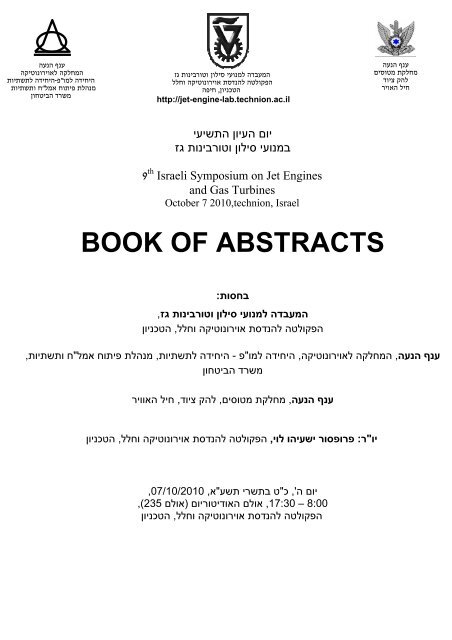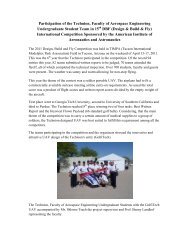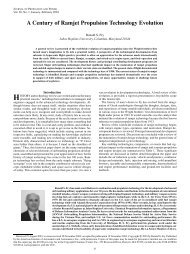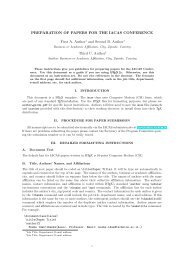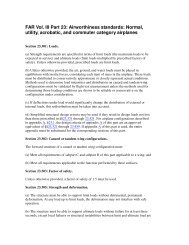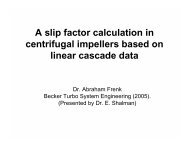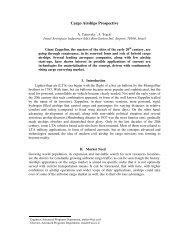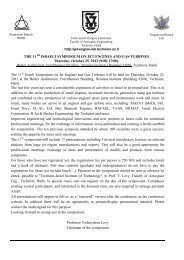BOOK OF ABSTRACTS - Faculty of Aerospace Engineering - הטכניון
BOOK OF ABSTRACTS - Faculty of Aerospace Engineering - הטכניון
BOOK OF ABSTRACTS - Faculty of Aerospace Engineering - הטכניון
You also want an ePaper? Increase the reach of your titles
YUMPU automatically turns print PDFs into web optimized ePapers that Google loves.
הענה ףנע<br />
הקיטונוריואל הקלחמה<br />
תויתשתל הדיחיה -פ"<br />
ומל הדיחיה<br />
תויתשתו ח " למא חותיפ תלהנמ<br />
ןוחטיבה דרשמ<br />
יעישתה ןויעה םוי<br />
זג תוניברוטו ןוליס יעונמב<br />
9 th Israeli Symposium on Jet Engines<br />
and Gas Turbines<br />
October 7 2010,technion, Israel<br />
<strong>BOOK</strong> <strong>OF</strong> <strong>ABSTRACTS</strong><br />
, תויתשתו ח"<br />
למא חותיפ תלהנמ<br />
זג תוניברוטו ןוליס יעונמל הדבעמה<br />
ללחו הקיטונוריוא תס דנהל הטלוקפה<br />
הפיח , ןוינכטה<br />
http://jet-engine-lab.technion.ac.il<br />
: תוסחב<br />
, זג תוניברוטו<br />
ןוליס יעונמל הדבעמה<br />
ןוינכטה<br />
, ללחו הקיטונוריוא תסדנהל הטלוקפה<br />
, תויתשתל הדיחיה - פ"<br />
ומל הדיחיה<br />
ןוחטיבה דרשמ<br />
ריוואה ליח , דויצ קהל , םיסוטמ תקלחמ , הענה ףנע<br />
, הקיטונוריואל הקלחמה , הענה ףנע<br />
ן וינכטה , ללחו הקיטונוריוא תסדנהל הטלוקפה , יול והיעשי רוספורפ : ר"<br />
וי<br />
, 07/10/2010 , א"<br />
עשת ירשתב ט"<br />
כ ,'ה<br />
םוי<br />
, ( 235 םלוא)<br />
םוירוטידואה םלוא , 17:30 – 8:00<br />
ן וינכטה , ללחו הקיטונוריוא תסדנהל הטלוקפה<br />
הענה ףנע<br />
םיסוטמ תקלחמ<br />
דויצ קהל<br />
ריואה ליח
הענה ףנע<br />
הקיטונוריואל הקלחמה<br />
תויתשתל הדיחיה -פ"<br />
ומל הדיחיה<br />
תויתש תו ח"<br />
למא חותיפ תלהנמ<br />
ןוחטיבה דרשמ<br />
יעישתה ןויעה םוי<br />
זג תוניברוטו ןוליס יעונמב<br />
9 th Israeli Symposium on Jet Engines<br />
and Gas Turbines<br />
October 7 2010,technion, Israel<br />
<strong>BOOK</strong> <strong>OF</strong> <strong>ABSTRACTS</strong><br />
, תויתשתו ח"<br />
למא חותיפ תלהנמ<br />
זג תוניברוטו ןוליס יעונמל הדבעמה<br />
ללחו הקיטונוריוא תסדנהל הטלוקפה<br />
הפיח , ןוינכטה<br />
http://jet-engine-lab.technion.ac.il<br />
: תוסחב<br />
, זג תוניברוטו<br />
ןוליס יעונמל הדבעמה<br />
ןוינכטה<br />
, ללחו הקיטונוריוא תסדנהל הטלוקפה<br />
, תויתשתל הדיחיה - פ"<br />
ומל הדיחיה<br />
ןוחטיבה דרשמ<br />
ריוואה ליח , דויצ קהל , םיסוטמ תקלחמ , הענה ףנע<br />
2<br />
, הקיטונוריואל הקלחמה , הענה ףנע<br />
ן וינכטה , ללחו הקיטונוריוא תסדנהל<br />
הטלוקפה , יול והיעשי רוספורפ : ר"<br />
וי<br />
, 07/10/2010 , א"<br />
עשת ירשתב ט"<br />
כ ,'ה<br />
םוי<br />
, ( 235 םלוא)<br />
םוירוטידואה םלוא , 17:30 – 8:00<br />
ן וינכטה , ללחו הקיטונוריוא תסדנהל הטלוקפה<br />
הענה ףנע<br />
םיסוטמ תקלחמ<br />
דויצ קהל<br />
ריואה ליח
ללחהו הפועתה יעדמל הדוגאה<br />
לארשיב<br />
הדוגאה – םיסדנהמה תכשל<br />
תונוכמ תסדנהל<br />
תודות<br />
ACKNOWLEDGEMENTS<br />
: ןויעה םוי םויקב וכמתש תודסומלו םיפוגל תודוהל וננוצרב<br />
3<br />
ריוואה ליח<br />
ת"<br />
אפמ<br />
לארשיל יגולונכט ןוכמ – ןוינכט<br />
: סנכה םוסרפל<br />
ל"<br />
אפר<br />
תודות
הענה ףנע<br />
הקיטונוריואל הקלחמה זג תוניברוטו ןוליס יעונמל הדבעמה<br />
תויתשתל הדיחיה -פ"<br />
ומל הדיחיה<br />
ללחו הקיטונוריוא תסדנהל הטלוקפה<br />
תויתשתו ח " למא חותיפ תלהנמ<br />
הפיח , ןוינכטה<br />
ןוחטיבה דרשמ<br />
http://jet-engine-lab.technion.ac.il<br />
( 235<br />
זג תוניברוטו ןוליס יעונמב יעישתה ילארשיה ןויעה<br />
םוי<br />
רדח)<br />
םוירוטידואה םלוא ( 08:00-17:00)<br />
07/10/2010 , א"<br />
עשת ירשת 'טכ<br />
,'ה<br />
םוי<br />
הפיח , ןוינכטה<br />
, ללחו הקיטונוריווא תסדנהל הטלוקפה ןיינב<br />
9 th Israeli Symposium on Jet Engines and Gas Turbines<br />
<strong>Faculty</strong> building <strong>of</strong> <strong>Aerospace</strong> <strong>Engineering</strong>, Technion, Haifa<br />
CHAIRMAN: Pr<strong>of</strong>essor Yeshayahou Levy*<br />
הענה ףנע<br />
םיסוטמ תקלחמ<br />
דויצ קהל<br />
ריואה ליח<br />
08:00 - 09:10 המשרה (Registration)<br />
7. Pr<strong>of</strong>. Yeshayahou Levy, "Low NOx Flameless<br />
Opening:<br />
Combustion for Jet Engines and Gas turbines",<br />
Pr<strong>of</strong>essor Yoram Tambur , Dean, <strong>Faculty</strong> <strong>of</strong><br />
<strong>Aerospace</strong> <strong>Engineering</strong>, Technion.<br />
Technion, Israel<br />
Pr<strong>of</strong>essor Yeshayahou Levy, Chairman, Head,<br />
Turbo and Jet Engine Laboratory, <strong>Faculty</strong> <strong>of</strong><br />
<strong>Aerospace</strong> <strong>Engineering</strong>, Technion.<br />
13:10 - 14:30 הדבעמב ר ויסו םיירהצ תחורא (Lunch)<br />
14:30 - 16:55 ינש בשומ (Second Session)<br />
9:30 - 13:10 ןושאר בשומ (First Session)<br />
Session Chairman: Major Amit Langer, IAF<br />
Session Chairman: Mr Emanuel Liban, Edmatech<br />
1. Amy Rose Nordmark, "Strategy for Design and<br />
Implementation <strong>of</strong> Diagnostic, Prognostic, and Health<br />
Management Systems for Optimal Value", Pratt &<br />
Whitney, USA.<br />
2. Tim Higgins, "Helicopter Engine Technology in the<br />
21st Century", GE Aviation, USA.<br />
3. Beni Cukurel, "Particle Image Velocimetry<br />
Investigation <strong>of</strong> a High Speed Centrifugal<br />
Compressor Diffuser", Purdue University, IN, USA<br />
8. Dr. Kuti Elazar, "Certification Process for Small Jet<br />
Engines", MoD, Israel<br />
9. Ilan Berlowitz, "All/More Electric Aircraft Engine &<br />
Airframe Systems Implementation", Bedek Aviation<br />
Group, Aircraft Programs Division, Israel <strong>Aerospace</strong><br />
Industries, Israel<br />
10. Gil Strauss, "Adaptation <strong>of</strong> Production and<br />
Metrology Methods to the Continuously Changing<br />
Requirements <strong>of</strong> Jet Engines Manufacturers". Blades<br />
Technology Ltd. Israel<br />
11:00-11:20 לק דוביכו הקספה (Break and refreshments) 15:30 - 15:50 לק דוביכו הקספה (Break and refreshments)<br />
4. Pr<strong>of</strong>. Mounir Ibrahim, "LES and URANS<br />
Computational Investigation <strong>of</strong> LPT Blade Separation<br />
Control Using Vortex Generator Jets", Cleveland<br />
State University, USA<br />
5. Dr. David Lior, "Recuperator Design for 90KW<br />
Turboprop/Turboshaft", RJet <strong>Engineering</strong>, Israel<br />
6. Dr. Amiram Leitner, "On the Development <strong>of</strong> a<br />
Micro Jet Engine, Case Study", Rafael, Israel<br />
11. Vladimir Krapp, "Computerized Micro Jet Engine<br />
Test Facility", Technion, Israel<br />
12. Dr. Rammy Shellef, "Hybrid Aerodynamic Bearing<br />
for Turbo Machinery", Ettem Eng. LTD.,Israel.<br />
13. Yochanan Nachmana, "Jet Engine Turbine Blade<br />
Thermal Mapping Results", Bet Shemesh Engines<br />
Ltd., Israel.<br />
16:50 - 16:55 םוכיס ירבד (Closure)<br />
*Pr<strong>of</strong>. Yeshayahou Levy: E-mail: levyy@aerodyne.technion.ac.il Tel: +972 4 8293807 Fax: +972 4 8121604 Mobile +972 547 355890<br />
4
הענה ףנע<br />
הקיטונוריואל הקלחמה<br />
תויתשתל הדיחיה -פ"<br />
ומל הדיחיה<br />
תויתשתו ח"<br />
למא חותיפ תלהנמ<br />
ןוחטיבה דרשמ<br />
קוסעי<br />
, ( 235<br />
זג תוניברוטו ןוליס יעונמל הדבעמה<br />
ללחו הקיטונוריוא תסדנהל הטלוקפה<br />
הפיח , ןוינכטה<br />
http://jet-engine-lab.technion.ac.il<br />
זג תוניברוטו ןוליס יעונמב יעישתה ןויעה<br />
םוי<br />
רדח)<br />
םוירוטידואה םלוא , ( 17:00 – 08:00)<br />
07/10/2010 , א"<br />
עשת ירשת<br />
הפיח , ןוינכטה , ללחו הקיטונוריווא תסדנהל הטלוקפה ןיינב<br />
זג תוניברוטו ןוליס יעונמב ןויעה םוי<br />
. הנשל הנשמ ץראב תבחרתמ<br />
וז היישעת<br />
. זג תוניברוטו<br />
ןוליס<br />
למשחה תרבח י"<br />
ע זג תוניברוט תרזעב ץראב למשחה רוצי רובגת<br />
יעונמב<br />
'טכ<br />
,'ה<br />
םוי<br />
יעישתה ןויעה םויל םיאבה םיכורב<br />
. תינוליסה הענהה םוחתל םיכיישה הסדנהה ימוחתב תוליעפב<br />
, ןוחטיבה דרשמ ןומימב םישדח םיטקיורפ<br />
עינמ חכ םיווהמ א"<br />
חב ןוליס יעונמ לש ידיתע ןונכתו תפטוש<br />
הקוזחתב תועגונה<br />
תויעבו םייטרפ םיפוגו<br />
ףוליח יקלחו יתרדס םיעונמ רוצי לש תפטושה תוליעפל ףסונב תאז לכ<br />
. אשונב םיבר םיטקיורפו םיחותפל<br />
ליח , א"<br />
ח , ת"<br />
אפמ םהבו הז םוחתב ףטושו ליעפ ןפואב ץראב םיקסוע םיפוג לש בר רפסמ . דועו הקוזחת , םינוש<br />
, RJET<br />
ו הסדנה רקב<br />
, RSL<br />
, למשחה תרבח<br />
, תמרוא<br />
, ש"<br />
עת<br />
, ל"<br />
אפר<br />
, שמש תיב יעונמ<br />
, א"<br />
עת<br />
, לע-לא<br />
הענה ףנע<br />
םיסוטמ תקלחמ<br />
דויצ קהל<br />
ריואה ליח<br />
, םיה<br />
. םירחא םיבר דועו ןוינכטה , SIF , םיבהל תויגולונכט<br />
לש םמויק ךשמה תא םיקידצמ ץראב םילהנתמה םישדח םיטקיורפו םייגולונכט םישודיח , םייסדנה<br />
. הלועפ<br />
יפותיש<br />
דודיעל<br />
היירופ<br />
עקרק<br />
םיווהמו<br />
עדימ תפלחהו<br />
תידדה הירפהל<br />
םידעוימה<br />
םייעוצקמ<br />
םירופיש<br />
םישגפמ<br />
םוחתמ םינעדמו םיסדנהמ האמכ םעפ לכב ושגפנו וסנכתה התע דע ומייקתהש םימדוקה ןויעה ימי תנומשב<br />
ימי<br />
, םיפתתשמה תכרעהלו הימדקאהמו ט"<br />
בהשממ<br />
. ל"<br />
וחמו ץראהמ םיחרוא םיצרמ י"<br />
ע<br />
, םירחבנ םיאשונב<br />
, ל"<br />
וחבו ץראב תונושה תוישעתהמ תודובע וגצוה<br />
, הענהה<br />
... דוע לש םעט םע ומייתסהו םיחלצומכ<br />
ורדגוה ןויעה<br />
תונמזומ אובמ תואצרה תרדס<br />
לולכי<br />
יחכנה ןויעה םוי<br />
ןויד , ץראב תואטיסרבינואבו<br />
םינוכמב<br />
, םילעפמב תונושה תויוליעפה לע תורצק תוגצה לולכי ןויעה םוי , ףסונב<br />
תפלחה , םייעוצקמ םישגפמל הבוט תונמדזה היהת וז , ןכ ומכ . הטלוקפה תודבעמב<br />
םירויס םג השירד פ"<br />
עו<br />
חותפ<br />
. תונוש תורבח י"<br />
ע םירצומו םימגד תגצהו תועד<br />
לש הקימנידוריווא ללוכ , זג תוניברוטו ןוליס יעונמל םייטנוולרה היגולונכטה ימוחת לכב ןודל תורשפא ןתנית<br />
הלועפ ירוזחמ<br />
, הקוזחתו רוציי יכילהת<br />
, םירמוח<br />
, הרקבו<br />
תויצלומיס<br />
, הקימאנידו<br />
הנבמ<br />
, הפירש<br />
, תונוכמ-וברוט<br />
דיתעבו)<br />
םימדוק ןויע ימימ תוגצמ . ץראב ןיינעו תוליעפ יאשונל ןתנית תופידע . דועו זג תוניברוט לש םיבלושמ<br />
. / http://jet-engine-lab.technion.ac.il<br />
: רתאה לש רעשה דומע<br />
ןויעה םוי ר"<br />
וי<br />
, הכרבב<br />
, יול והיעשי רוספורפ<br />
5<br />
ךרד תוארל ןתינ<br />
( הז ןויע םוי לש םג<br />
בורקה<br />
! חלצומו הרופ ןויע םוי ונלוכל לחאמ<br />
ינא<br />
.
הענה ףנע<br />
הקיטונוריואל הקלחמה<br />
תויתשתל הדיחיה -פ"<br />
ומל הדיחיה<br />
תויתשתו ח " למא חותיפ תלהנמ<br />
ןוחטיבה דרשמ<br />
זג תוניברוטו ןוליס יעונמל הדבעמה<br />
ללחו הקיטונוריוא תסדנהל הטלוקפה<br />
הפיח , ןוינכטה<br />
http://jet-engine-lab.technion.ac.il<br />
9 th Symposium on Jet Engines and Gas Turbines<br />
Thursday, October 7, 2010 (8:00-17:00), Seminar Hall (Room 235)<br />
<strong>Faculty</strong> <strong>of</strong> <strong>Aerospace</strong> <strong>Engineering</strong>, Technion, Haifa<br />
This year, as in previous years, we plan to hold the Symposium on Jet Engines and Gas<br />
Turbines. The last few years there has seen a considerable expansion <strong>of</strong> activities in Isreal in<br />
jet propulsion, in addition to the serial production <strong>of</strong> small engines, Electricty generation<br />
using gas turbines, production <strong>of</strong> various engines' spare parts and maintenance work. In Israel<br />
many bodies are active in this area including: MAFAT, IAF, Israel Navy, EL-AL, IAI, Beit<br />
Shemesh Engines, RAFAEL, TAAS, ORMAT, Israel Electric Corporation, RSL, Becker<br />
<strong>Engineering</strong>, the Technion and more.<br />
Improved engineering & technological innovations and new projects in Israel calls for<br />
continued pr<strong>of</strong>essional meetings for exchange <strong>of</strong> information and cross-pollination, creating a<br />
fertile seedbed for cooperation. During the previous eight symposia, every time, about<br />
hundred scientists and propulsion engineers met and presented work from various industries,<br />
the MoD and Academia. These symposia were a success, wetting the appetite for more such<br />
meetings.<br />
The symposium will include invited introductory lectures on selected subjects (from large<br />
manufacturers abroad; GE, P&W & / or Rolls Royce). In addition there will also be<br />
presentations <strong>of</strong> activities in Israeli firms, institutes and universities as well as an open<br />
discussion and tour <strong>of</strong> faculty laboratories. This will also be a good opportunity for<br />
pr<strong>of</strong>essional meetings, exchange <strong>of</strong> ideas and presentation <strong>of</strong> models and products from<br />
various companies.<br />
During the symposium there will be an opportunity to discuss all areas relevant to jet engines<br />
and gas turbines, including aerodynamics <strong>of</strong> turbo-machines, combustion, structures and<br />
dynamics, simulations, control, production processes and maintenance, combined cycles and<br />
more. Preference will be given to subjects <strong>of</strong> interest in Israel.<br />
Looking forward to a successful symposium,<br />
Pr<strong>of</strong>essor Yeshayahou Levy - Chairman <strong>of</strong> the symposium<br />
6<br />
הענה ףנע<br />
םיסוטמ תקלחמ<br />
דויצ קהל<br />
ריואה ליח
Lecture #1<br />
Strategy for Design and Implementation <strong>of</strong> Diagnostic, Prognostic, and Health<br />
Management Systems for Optimal Value<br />
Ms. Amy Rose Nordmark<br />
Systems Analysis Chief, Operational Military Engines<br />
United Technologies / Pratt & Whitney<br />
East Hartford, CT USA<br />
amy.nordmark@pw.utc.com<br />
Public Release # xxxxx<br />
This paper contains forward-looking statements concerning future business opportunities. Actual results may differ materially<br />
from those described as a result <strong>of</strong> certain risks and uncertainties, including challenges in the design, development, production<br />
and support <strong>of</strong> advanced technologies; as well as other risks and uncertainties, including but not limited to those detailed from<br />
time to time in United Technologies Corporation's Securities and Exchange Commission filings.<br />
ABSTRACT<br />
Diagnostics, Prognostics, and Health Management, or DPHM, is an emerging field that is<br />
generating much interest in the aerospace community. Everyone wants it, but there cannot be<br />
a ‘one size fits all’ approach to designing and implementing DPHM systems. Successful<br />
design and implementation is achieved by considering the specific program’s data availability,<br />
infrastructure, and sensor suite. The decision to invest is based on a business case that<br />
quantifies benefits in safety, ownership cost, and readiness. The strategy is to tailor transition<br />
<strong>of</strong> technology in a way that optimizes value for engines at every stage in the life cycle, from<br />
new development to extended service.<br />
This presentation reviews the strategy for deploying DPHM systems in Pratt and Whitney’s<br />
military engines. The key is to identify unique program needs up front. A program may be<br />
focused on interval extension, improved readiness, or a basic philosophy change from<br />
scheduled to Condition Based Maintenance (CBM). In all cases, data can be used to focus<br />
the DPHM effort. Reliability, Maintainability, and Safety (RMS) data can be used to identify<br />
drivers to time on wing, maintenance manhours, and inflight shutdowns. Market feedback can<br />
provide additional insight to ‘high pain’ issues in the field.<br />
Once the program need is defined, DPHM technologies such as usage based lifing, physics<br />
based damage tracking, sensor technology, and advanced anomaly detection and fault<br />
isolation can be evaluated for impact to the relevant engine life management metric. A cost –<br />
benefit study is conducted to provide the recommended solution. The system is designed,<br />
tested, validated, and demonstrated in the field. The result is a system that delivers<br />
information to improve decision making at every level: flight line, base operations, and depot.<br />
7
Lecture #2<br />
ABSTRACT<br />
Helicopter Engine Technology in the 21st Century<br />
Tim Higgins,<br />
GE Aviation, USA<br />
tim.j.higgins@ge.com<br />
Military helicopter operators are operating in taxing environments that are exceeding the<br />
capabilities <strong>of</strong> today's helicopter engines. The users are requiring higher power to operate<br />
in hot and high altitude locations. More fuel-efficient engines are needed to increase the<br />
range and payload <strong>of</strong> the rotorcraft, and to minimize the need for flying or trucking fuel to<br />
support these missions. Forward deployment <strong>of</strong> fuel is not only extremely costly, but<br />
exposes the personnel to hazardous conditions. Sand is a big challenge in some <strong>of</strong> these<br />
theaters, degrading the performance <strong>of</strong> engines, driving maintenance workload and<br />
adversely affecting operational readiness. Sand erodes compressor blades, plugs cooling<br />
circuits and spalls thermal barrier coatings. Engines that should run for thousands <strong>of</strong> hours<br />
are driven <strong>of</strong>f wing for low performance in 100-200 hours, in extreme sand environments.<br />
Engine technology advances allow engines to provide higher power, be more fuel efficient,<br />
and tolerate operation in harsh sand conditions. The latest in aerodynamics, materials/<br />
coatings and cooling technology are being applied to a new generation <strong>of</strong> turbo-shafts like<br />
the GE38-1B engine, to address the operational needs <strong>of</strong> the 21st century. Further<br />
advances in materials and component design currently being developed will make the<br />
following generation <strong>of</strong> engines more fuel efficient, smaller and lighter.<br />
8
Lecture #3<br />
ABSTRACT<br />
Particle Image Velocimetry Investigation <strong>of</strong> a High Speed Centrifugal<br />
Compressor Diffuser<br />
Cukurel, Beni,<br />
Purdue University, IN, USA – currently at von Karman Institute for Fluid<br />
Dynamics, Rhode-St-Genese, Belgium.<br />
cukurel@vki.ac.be<br />
The future <strong>of</strong> small gas turbines rely on higher efficiency and pressure ratio centrifugal compressors.<br />
An efficient diffuser is essential to the performance, durability and operability <strong>of</strong> a compressor stage.<br />
The diffuser entry flow in a high speed centrifugal compressor is highly unsteady and complex,<br />
featuring shocks, boundary layer/shock interactions, and large incidence variations. To characterize<br />
the spanwise and circumferential variations in the vaned diffuser passage <strong>of</strong> a modern transonic<br />
centrifugal compressor, Particle Image Velocimetry experiments are conducted in the Purdue High<br />
Speed Centrifugal Compressor facility. The flow characteristics are analyzed from hub to- shroud<br />
over a range <strong>of</strong> steady loadings at several relative impeller diffuser positions.<br />
The data at all loading conditions demonstrated that the flow field in the diffuser is characterized by<br />
a much more complicated structure than that which would be associated with steady, uniform<br />
diffusion. Although mixing clearly occurs in the vaneless space, these data show that strong<br />
momentum variations still exist in both the spanwise and the circumferential directions in the<br />
diffuser. Diffuser throat structures were shown to vary significantly with loading. Near the choke<br />
line, the incidence angles and blockage <strong>of</strong> the separation bubble served to form a converging<br />
diverging nozzle and take the approach flow supersonic. The flow then adjusts to subsonic through<br />
an oblique and then a normal shock. A further increase in the loading results in a more mild<br />
supersonic flow, and an adjustment to subsonic flow through a normal shock. As the mass flow is<br />
further decreased, the entire diffuser flow becomes subsonic. Hub-to-shroud variations are greater<br />
for the higher loading conditions; the main cause being a larger impeller wake region imposed in the<br />
shroud-plane. As the compressor is throttled towards stall, the hub-to-shroud variations are further<br />
enhanced as the flow breaks down in the diffuser hub. Consequently, the increased blockage in the<br />
hub diverts the core flow towards the shroud.<br />
9
Lecture #4<br />
LES and URANS Computational Investigations <strong>of</strong> LPT Blade (L1A)<br />
Separation Control using Vortex Generator Jets<br />
M. B. Ibrahim<br />
Department <strong>of</strong> Mechanical <strong>Engineering</strong>, Cleveland State University, OH 44115,<br />
m.ibrahim@csuohio.edu<br />
Abstract<br />
Boundary layer separation on the suction side <strong>of</strong> low-pressure turbine (LPT) airfoils can occur due to strong<br />
adverse pressure gradients. Active flow control could provide a means for minimizing separation under conditions<br />
where it is most severe (low Re), without causing additional losses under other conditions (high Re). Along with the<br />
experimental investigations, numerical simulations <strong>of</strong> the flow over LPT blades, utilizing steady and pulsed vortex<br />
generator jets (VGJs) were performed by different researchers.<br />
The L1A airfoil, used in this study, was designed at the Air Force Research Laboratory (AFRL). The separation<br />
bubble on the L1A is about four times thicker than that on the Pack B. This study describes active flow control utilizing<br />
steady and pulsed VGJs both experimentally and computationally for the L1A airfoil. Cases were considered at exit Re =<br />
25,000, 50,000 and 100,000. In all cases without flow control, the boundary layer separated and did not reattach. The<br />
VGJs were successful in reducing the bubble size or removing it completely depending on the Re and B (blowing ratio).<br />
Experiments were conducted in a closed loop wind tunnel with a seven blade linear cascade located in the wind<br />
tunnel’s third turn, as shown in Fig. 1a. As for the VGJ,<br />
the holes are 0.8 mm in diameter and drilled at 30° to the<br />
surface and 90° to the main flow direction (see Figure 1b).<br />
Figures 2, 3 and 4 show (respectively), Cp for Case<br />
(2)F=0.07, Case (5) F=0.28, and Case (6) F=0.56, for Re=<br />
50,000, B=0.5 and DC=10%. [F is dimensionless<br />
frequency <strong>of</strong> jet pulsation and DC is duty cycle.]<br />
The CFD was done with URANS and LES utilizing<br />
version 6.3.26 <strong>of</strong> the finite-volume code ANSYS Fluent.<br />
The CFD did provide further insight to better understand<br />
the physics <strong>of</strong> flow control. The comparison between CFD<br />
and experimental results for Cp, velocity pr<strong>of</strong>iles and ψint<br />
is reasonable for all cases examined. Transition-sst RANS<br />
model was successful in predicting the flow separation<br />
and attachments with no jet flow. LES showed superior<br />
performance for the VGJs cases and much better<br />
agreement with the experimental data for the flow field at<br />
different values <strong>of</strong> Re and B.<br />
screen<br />
B7<br />
flap<br />
B6<br />
B5<br />
B4<br />
B3<br />
B2<br />
B1<br />
tailboard<br />
flap<br />
Figure 1a.<br />
Schematic <strong>of</strong><br />
linear cascade<br />
Figure 1b.<br />
Airfoil with VGJ<br />
holes and cross<br />
section <strong>of</strong> hole<br />
geometry.<br />
Cp<br />
Cp<br />
Re = 50,000<br />
Exp, No Jet<br />
CFD, B=0.5, f=3, DC=10<br />
2.0<br />
1.8<br />
1.6<br />
1.4<br />
1.2<br />
1.0<br />
0.8<br />
0.6<br />
0.4<br />
0.2<br />
0.0<br />
0 0.2 0.4 0.6 0.8 1<br />
s/Ls<br />
Cp<br />
10<br />
Re = 50,000<br />
2.5<br />
2.0<br />
1.5<br />
1.0<br />
0.5<br />
0.0<br />
Exp. B=1, f=12 Hz, DC=10<br />
Exp, B=0.5, f=12, DC=10<br />
CFD, B=0.5, f=12, DC=10<br />
0 0.2 0.4 0.6 0.8 1<br />
s/Ls<br />
Re = 50,000<br />
2.5<br />
2.0<br />
1.5<br />
1.0<br />
0.5<br />
Exp, B=0.5, f=24, DC=10<br />
CFD, B=0.5, f=24, DC=10<br />
0.0<br />
0.00 0.20 0.40 0.60 0.80 1.00<br />
s/Ls<br />
Figure 2. Cp for Case<br />
(2), Re= 50,000,<br />
B=0.5, F=0.07,<br />
Figure 3. Cp for Case<br />
(5), Re= 50,000,<br />
B=0.5, F=0.28,<br />
Figure 4. Cp for Case<br />
(6), Re=50,000,<br />
B=0.5, F=0.56,
Lecture #5<br />
ABSTRACT<br />
A RECUPERATED 90 KW AEROSPACE GAS TURBINE<br />
Dr. David Lior<br />
General manager <strong>of</strong> R-JET and Becker Turbo System<br />
d.lior@rjet-eng.com<br />
A recuperated gas turbine cycle is analyzed and optimized for a 90kw turboshaft in<br />
aerospace applications. During the last 25 years many attempts have been done to install a<br />
recuperated gas turbine in some aircraft types-but size and weight limitation did not justify<br />
such a configuration. It is demonstrated that smaller lighter recuperators may be used When<br />
the flight mission is mainly at altitude ,where the airflow is reduced and consequently the<br />
recuperator effectiveness is increased and the pressure drops are decreased .<br />
Some recuperator and regenerator types are presented, the counter-flow fin and plate type is<br />
chosen for the proposed application.<br />
Two methods to explore the recuperator effectiveness and pressure drops are analyzed and<br />
discussed—a close agreement between the methods is found.<br />
Accordingly-the recuperator design is optimized for a reduced flow resulting in small weight<br />
and compact configuration. In full power at sea level the engine thermal efficiency is lower<br />
–<br />
which is tolerated at conventional aerospace flight missions in which seal level flight is used<br />
for take-<strong>of</strong>f and landings.<br />
This configuration is compared to other propulsion engines -a piston engine, a rotary piston<br />
engine, a gas turbine with a high cycle pressure and a low cycle pressure ratio gas turbine<br />
with a large recuperator optimized for full power conditions.<br />
The comparison is done on aircraft endurance as function <strong>of</strong> total free weight available for<br />
the engine itself and the fuel weight. , a range between 150—400 kg <strong>of</strong> total weight is<br />
explored.<br />
It is found that the best economic engine [ highest endurance] is the partly recuperated gas<br />
-turbine , the piston engine is second best, but is limited to benzene which poses a safety<br />
hazard.<br />
The diesel engine has not been analyzed due to its high weight and reduced efficiency at<br />
high Altitudes-the suggested solution has the same thermal efficiency as the diesel [ 35%].<br />
Manufacturing in Israel is feasible.<br />
11
Lecture #6<br />
On the Development <strong>of</strong> a Micro Jet Engine, Case Study,<br />
ריעז ינוליס עונמ חותיפ<br />
Dr. Amiram Leitner,<br />
Rafael, Israel<br />
רד<br />
'<br />
רנטייל םרימע<br />
,<br />
תינוליס הענה תקלחמ שאר<br />
,<br />
לאפר<br />
amiraml@rafael.co.il<br />
ריצקת<br />
תקלחמ<br />
הענה<br />
תינוליס<br />
המקוה<br />
תביטחב<br />
רונמ<br />
אפרב<br />
"<br />
ל<br />
תנשב<br />
2003<br />
תקסועו<br />
חותיפב<br />
רוט<br />
וב<br />
תונוכמ<br />
תמגוד<br />
יעונמ<br />
ןוליס<br />
םיריעז<br />
,<br />
תוכרעמ<br />
קפסה<br />
,<br />
תוכרעמ<br />
רוריק<br />
גוסמ<br />
Air Cycle Machine<br />
ינקתמו<br />
יוסינ<br />
םיידועי<br />
.<br />
טקיורפה<br />
יזכרמה<br />
הקלחמב<br />
וניה<br />
חותיפ<br />
עונמ<br />
ינוליס<br />
ריעז<br />
ילארשי<br />
"<br />
לוחכ<br />
ןבל<br />
"<br />
לכש<br />
וחותיפ<br />
השענ<br />
לארשיב<br />
תאזו<br />
הנושארל<br />
ץראב<br />
.<br />
חותיפ<br />
עונמה<br />
השענ<br />
ךות<br />
תונעשיה<br />
לע<br />
עדי<br />
חרנ<br />
ב<br />
לש<br />
רפסמ<br />
םינעדמ<br />
םילוע<br />
הירבמ<br />
"<br />
מ<br />
רבעשל<br />
.<br />
עונמה<br />
וניה<br />
גוסמ<br />
וברוט<br />
-<br />
ןוליס<br />
לעב<br />
הנבמ<br />
"<br />
יסאלק<br />
:"<br />
ריצ<br />
דחא<br />
,<br />
סחדמ<br />
ילגופירטנצ<br />
,<br />
את<br />
הפירש<br />
יראלונא<br />
,<br />
הניברוט<br />
תיריצ<br />
,<br />
רוניצ<br />
הטילפ<br />
סנכתמ<br />
.<br />
ומכ<br />
ןכ<br />
,<br />
עונמה<br />
דיוצמ<br />
ירזיבאב<br />
הענתה<br />
התצהו<br />
םיינכטוריפ<br />
רוטאנרטלאבו<br />
רציימה<br />
קפסה<br />
ילמשח<br />
.<br />
חותיפ<br />
עונמה<br />
,<br />
אצמנה<br />
ויבלשב<br />
םייפוסה<br />
,<br />
ללכ<br />
תא<br />
םיבלשה<br />
םיירקיעה<br />
םיאבה<br />
:<br />
<br />
שוביג<br />
טרפמ<br />
תושירד<br />
תוירקיע<br />
<br />
רקס<br />
תופולח<br />
תרוצתל<br />
עונמ<br />
<br />
ןכת<br />
ימאנידוריוא<br />
ינאכמו<br />
לש<br />
יביכר<br />
עונמ<br />
ללוכ<br />
תוזילאנא<br />
תושרדנ<br />
<br />
ייוסינ<br />
חותיפ<br />
לש<br />
םיביכרה<br />
<br />
ייוסינ<br />
חותיפ<br />
לש<br />
עונמה<br />
יאנתב<br />
SLS<br />
,<br />
ינקתמב<br />
יומיד<br />
הבוג<br />
םיידועי<br />
ייוסינו<br />
אנת<br />
י<br />
הביבס<br />
<br />
ינוכדע<br />
ןכת<br />
יפל<br />
תואצות<br />
םייוסינ<br />
<br />
תנכה<br />
יכומיס<br />
רוציי<br />
חותיפ<br />
םיביכרה<br />
ללכ<br />
ןכת<br />
תוזילאנאו<br />
תוימאנידוריוא<br />
,<br />
ןכת<br />
ינאכמ<br />
,<br />
תוזילנא<br />
קזוח<br />
הקימאנידו<br />
.<br />
חותיפ<br />
סחדמה<br />
אתו<br />
הפירש<br />
ללכ<br />
ףא<br />
םייוסינ<br />
ינקתמב<br />
יוסינ<br />
םידועי<br />
.<br />
חותיפ<br />
את<br />
הפירשה<br />
היה<br />
ירגתא<br />
דחוימב<br />
ושרדנו<br />
רפסמ<br />
םיבבס<br />
דע<br />
איצמל<br />
ת<br />
הרוצת<br />
תדמועה<br />
תושירדב<br />
םייעוציב<br />
ךרואו<br />
םייח<br />
.<br />
ייוסינ<br />
חותיפ<br />
עונמה<br />
יאנתב<br />
SLS<br />
ושמיש<br />
הדידמל<br />
לש<br />
יעוציב<br />
עונמ<br />
םתמאתהו<br />
תושירדל<br />
טרפמה<br />
רקיעב<br />
לע<br />
ידי<br />
תריחב<br />
חטש<br />
ריחנ<br />
הטילפ<br />
ריחנו<br />
הניברוט<br />
.<br />
םייוסינה<br />
ושמיש<br />
םג<br />
חותיפל<br />
תכרעמ<br />
הרקבה<br />
לש<br />
עונמה<br />
.<br />
הרטמ<br />
הבושח<br />
תפסונ<br />
לש<br />
םייוסינה<br />
םייעקרקה<br />
התייה<br />
תחכוה<br />
ןמז<br />
הלועפה<br />
–<br />
יוסינ<br />
Endurance<br />
.<br />
ךלהמב<br />
חותיפה<br />
ועריא<br />
רפסמ<br />
תולקת<br />
עצובו<br />
ךילהת<br />
לש<br />
רקח<br />
תוביס<br />
הלקתה<br />
םושייו<br />
תונקסמה<br />
.<br />
ועצוב<br />
רפסמ<br />
תורדס<br />
לש<br />
םייוסינ<br />
ינקתמב<br />
יומידל<br />
הבוג<br />
רשא<br />
םתרטמ<br />
התייה<br />
תמגדה<br />
תפטעמ<br />
הלועפה<br />
לש<br />
עונמה<br />
,<br />
תדידמ<br />
םיעוציב<br />
תפטעמב<br />
הלועפה<br />
,<br />
חותיפ<br />
ךילהת<br />
נתה<br />
הע<br />
הבוגב<br />
תמגדהו<br />
תפטעמ<br />
הענתהה<br />
.<br />
12
Lecture<br />
# 7<br />
ABSTRACT<br />
Low NOx Flameless Combustion for Jet Engines and Gas turbines<br />
Pr<strong>of</strong>. Yeshayahou Levy,<br />
Technion, Israel<br />
levyy@aerodyne.technion.ac.il<br />
New designs <strong>of</strong> gas turbines combustors and jet engines must exhibit low NOx emissions in order to<br />
comply with the new environmental regulations. NOx emission values have to be reduced by at least<br />
one order <strong>of</strong> magnitude, to about 20 ppm and below (parts per millions <strong>of</strong> the gases in the exhaust).<br />
Current low NOx designs still suffer from combustion instability, flashback and low dynamic range.<br />
The present study is aimed toward understanding the basics <strong>of</strong> the low NOx, flameless combustion<br />
technique. The flameless combustion is characterized by combustion stability at low equivalence<br />
(fuel) ratio (thus low NOx), uniform temperature distribution, low turbulence and noise, low<br />
visibility and the requirement for relative large volume.<br />
A high momentum central jet entrains gases from the surroundings <strong>of</strong> its nozzle, creating a large<br />
recirculation, recirculating combustion products to the vicinity <strong>of</strong> the air nozzle. Fuel is injected into<br />
the recirculated gases prior to their mixing with the fresh air. Whenever temperature <strong>of</strong> the mixed<br />
reactance (fuel + air + recirculated combustion products) exceeds the spontaneous ignition<br />
temperature and the equivalence ration will be above a certain minimum value (typically 0.3-0.5),<br />
stable combustion will occur.<br />
Flameless combustion study is performed using a generic combustor assembly. Its objective is to<br />
gain better understanding <strong>of</strong> the physics involved. A combined theoretical – experimental study is<br />
performed together with the IST University in Lisbon, where the Technion is responsible for the<br />
theoretical aspect and IST performed the experimental part.<br />
Different operational conditions were examined, that are relevant for gas turbines and jet engines. It<br />
was realized that it is difficult to achieve flameless conditions in practical systems unless heat<br />
extraction mechanism is incorporated from the combustion zone. Hence, the incorporation <strong>of</strong> heat<br />
transfer mechanism (fins) was also studied. Promising results were achieved, however yet, at the<br />
cost <strong>of</strong> larger weight and volume. During the presentation the basic <strong>of</strong> the combustion phenomena,<br />
the combustion system, the results and possible practical implementation will be described.<br />
13
Lecture #8<br />
ABSTRACT<br />
Small Turbine Engine Certification<br />
Dr. Kuti Elazar,<br />
MoD, Israel<br />
elazar_k@hotmail.com<br />
Small Turbine Engines are classified to be in the category <strong>of</strong> 500 – 3000 lb thrust. Those engines are<br />
used in very light commercial jets or fast (above 0.5 mach) or high altitude (above 25000 feet)<br />
Unmanned Air Vehicles.<br />
It is common practice that the turbine engine follows a full certification process as a precondition to<br />
air vehicle flight tests. Engine contractor and air vehicle contractor deliver a detailed proposal <strong>of</strong><br />
engine certification process to air traffic authorities (such as FAA) that serve as the engineering<br />
authority for that matter. Update and approval <strong>of</strong> proposal by air traffic authorities is necessary for<br />
federal clearance.<br />
The Israeli administration lacks the experience for such processes; therefore the turbine engine<br />
community developed a certification process. The process was exercised on BSEL SOREQ turbine<br />
engine. The certification process addressed the following entities:<br />
Engine start performance<br />
Engine operation performance throughout the envelope<br />
Proper operation <strong>of</strong> engine interfaces<br />
Proper operation <strong>of</strong> engine in environmental conditions<br />
Proper operation <strong>of</strong> engine in different flight conditions<br />
Control system certification<br />
Oil system certification<br />
Electrical system certification<br />
Reliability<br />
Maintainability<br />
Engine life cycle<br />
Safety<br />
The certification process took place in the following facilities:<br />
Sea Level and Static engine test cell<br />
Altitude test cell simulating altitude and velocity<br />
IAI ASTRA flying test bed<br />
The project took place in the first half <strong>of</strong> the decade. SOREQ turbine engine demonstrated full<br />
compliance with requirement specification including life cycle, reliability and safety.<br />
14
Lecture #9<br />
ABSTRACT<br />
All/More Electric Aircraft Engine & Airframe Systems Implementation<br />
Ilan Berlowitz<br />
BEDEK Aviation Group, Aircraft & Programs Divisions<br />
Israel <strong>Aerospace</strong> Industries<br />
iberlow@iai.co.il<br />
Implementation <strong>of</strong> all or more electric technologies has the potential <strong>of</strong> improving the performance<br />
<strong>of</strong> a given aircraft. Savings can manifest through improved engine performance, reduced equipment<br />
weight and improved secondary power and airframe systems utilization. Adoption <strong>of</strong> a single form<br />
<strong>of</strong> secondary power and implementation <strong>of</strong> all or more electric technologies <strong>of</strong>fer distinct advantages<br />
over the conventional secondary power systems:<br />
Improved engine performance through the optimization <strong>of</strong> take<strong>of</strong>f and elimination <strong>of</strong> bleed<br />
air. These issues are critical as the bypass ratio <strong>of</strong> the engine increases and the size <strong>of</strong> the<br />
core reduces.<br />
Improved systems utilization and implementation <strong>of</strong> more efficient power units.<br />
Conventional secondary power systems were developed during the years that the fuel was<br />
relatively inexpensive and have not been optimized for maximum efficiency. Bleeding air<br />
from the engine is largely inefficient and a large amount <strong>of</strong> power is wasted for no useful<br />
purpose. In addition, hydraulic systems are <strong>of</strong>ten sized for loads that are small in duration<br />
thus increasing the mass and power requirements <strong>of</strong> the systems.<br />
Elimination <strong>of</strong> conventional hydraulic and bleed air systems could lead to a significant mass<br />
reduction. However, the mass and size <strong>of</strong> the electrical equipment would also increase and<br />
these changes must be accounted for.<br />
Additional benefits include reduced single type maintenance, improved reliability and life<br />
cycle costs.<br />
Studies evaluate that adoption <strong>of</strong> more electric technologies would introduce a small mass penalty.<br />
Mass savings can only be realized if the all electric concept is adopted, bleed air systems are<br />
eliminated and conventional hydraulic systems are replaced by local electro-hydrostatic actuation.<br />
Adoption <strong>of</strong> all electric technologies and elimination <strong>of</strong> the hydraulic and bleed air systems is<br />
estimated to reduce OEW by 0.5% for twin-engine wide-body aircraft (A330, B767). Reduction in<br />
MTOW and the reduced take<strong>of</strong>f penalties could allow an increase in engine bypass ratio, leading to<br />
an increased overall performance and fuel saving <strong>of</strong> 4.5%. Several power system architectures are<br />
possible. Generation and distribution <strong>of</strong> variable voltage variable frequency (VVVF) increase mass<br />
savings. The power output varies with engine/generator rotational speed and the generators can be<br />
sized for minimum requirements. Supply <strong>of</strong> VVVF power to induction motors improves their<br />
performance characteristics and eliminates the need to oversize the motors or use controllers.<br />
15
Lecture #10<br />
ABSTRACT<br />
Adaptation <strong>of</strong> Production and Metrology Methods to the Continuously<br />
Changing Requirements <strong>of</strong> Jet Engines Manufacturers.<br />
Gil Strauss,<br />
Blades Technology Ltd. Israel<br />
Gil gil.strauss@btl.co.il<br />
Historically, <strong>Aerospace</strong> industries were considered conservative. It is <strong>of</strong>ten characterized in<br />
the slow process <strong>of</strong> adaptation and implementation <strong>of</strong> technological changes especially in<br />
comparison to other technology-intensive industries.<br />
Recently, as a result <strong>of</strong> increasing competition and economical stresses, such as high fuel<br />
prices and strict environmental regulations, a change has been observed in the frequency and<br />
magnitude <strong>of</strong> engineering and design changes. These changes and new designs are followed by<br />
demand for fast reaction time from the suppliers.<br />
The new jet engines introduced to the market are based on new materials, complex designs<br />
and higher geometrical requirements.<br />
The change presents a dilemma for the manufacturers <strong>of</strong> aerospace components: On the one<br />
hand, massive investment in R&D and capital equipment is required to meet the needs and preserve<br />
the market position. On the other hand, the return on investment will be seen only after 5-7 years if<br />
the new project is successful.<br />
From the technological aspect, there is the need to manage numerous development projects<br />
that will meet the new requirements, and in parallel support the need for higher efficiency and cost<br />
reduction.<br />
Blades technology Ltd is a manufacturer <strong>of</strong> compressor and turbine blades for over 40 years.<br />
Among its customers one can find all major jet engine manufacturers and some <strong>of</strong> the leading<br />
manufacturers <strong>of</strong> IGT’s (Industrial Gas Turbines). As a supplier and partner <strong>of</strong> leading companies in<br />
the field, the company continuously invests in new production and metrology technologies.<br />
Some <strong>of</strong> the key projects will be presented to demonstrate the technological trends and the<br />
related solutions.<br />
Engine efficiency is highly dependent on the pr<strong>of</strong>ile <strong>of</strong> the turbine blade. The leading edge<br />
shape is a key factor in the overall performance. The manual pr<strong>of</strong>iling process cannot provide the<br />
accuracy and repeatability required by the new designs. Robotic pr<strong>of</strong>iling and measuring machines<br />
are developed and implemented in the production lines.<br />
A large portion <strong>of</strong> the rotating parts in an engine are made out <strong>of</strong> a single metal unit. High<br />
precision milling process are developed together with advanced metrology techniques<br />
16
The rapid changes and the need for flexibility require short response time in the<br />
industrialization process <strong>of</strong> new components. Computerized simulations and 3D imaging are used<br />
for shortening the development time and minimizing the number <strong>of</strong> iterations required.<br />
The competition in the market and the continuous need for cost reduction are the main drive<br />
for the implementation <strong>of</strong> automation and robotics. The immediate benefits are process stability and<br />
reliability followed by efficiency and cost reduction.<br />
17
Lecture #11<br />
Background<br />
Computerized Micro Jet Engine Test Facility<br />
Vladimir Krapp,<br />
Turbo & Jet Engine Laboratory, Technion<br />
svladk@t2.technion.ac.il<br />
Micro jet engines are recently used more significantly in model airplanes, UAV as well as for<br />
different glider applications. We, at the Turbo & Jet Engine Laboratory, decided to incorporate<br />
several test stands with micro jet engines because the ability to use them in <strong>Aerospace</strong> education, as<br />
affordable experimentation platforms and their usage in high-end recreational model airplane<br />
building.<br />
The facility built includes a fully computerized propulsion system, integrating the engine control and<br />
the measurement <strong>of</strong> all operation and thermodynamic parameters. An Olympus micro jet engine,<br />
manufactured by AMT Holland has been installed at the facility as a representative <strong>of</strong> its class. The<br />
engine is instrumented to allow measurement <strong>of</strong> temperatures and pressures along the gas path. The<br />
control and data acquisition system allows easy expansion through the use <strong>of</strong> multi-channel data<br />
acquisition cards and modular s<strong>of</strong>tware built in the LabVIEW programming environment.<br />
An experiment study that was able to successfully demonstrate the capabilities <strong>of</strong> the system is<br />
presented in the current talk: the measurement <strong>of</strong> thermal characteristics <strong>of</strong> the exhaust jet <strong>of</strong> the<br />
engine. In order to accomplish this, a set <strong>of</strong> external probes (temperature, pressure and gas<br />
composition) mounted on a computerized X-Y traverse system was added to the system. The<br />
different sensors' data were recorded by the same program controlling the engine’s operation, and a<br />
s<strong>of</strong>tware module, allowing traverse control through a step motor controller unit was added to the<br />
main s<strong>of</strong>tware package. A thermal camera was used to record the thermal radiation from the gaseous<br />
jet, and the data correlated at the end <strong>of</strong> the experiment to that acquired by the probes. The<br />
measurements were in good accordance with the theory <strong>of</strong> free jet behaviour.<br />
Conclusion<br />
The facility has proven a valuable addition to the Jet Engine Laboratory’s research capabilities.<br />
Future experiments planned include examination <strong>of</strong> the effect <strong>of</strong> inlet obstructions on engine<br />
performance, incorporation <strong>of</strong> variable nozzle and thrust vectoring, afterburner and more. Upgrading<br />
the system to allow testing <strong>of</strong> real time engine control algorithms is also in the works.<br />
18
Lecture #12<br />
ABSTRACT<br />
Hybrid Aerodynamic Bearings for Turbo Machinery<br />
(Patent Pending)<br />
Rammy A. Shellef<br />
Ettem <strong>Engineering</strong> S.A. Ltd<br />
gil.strauss@btl.co.il<br />
In the absence <strong>of</strong> liquid lube source for rotary bearings and barring magnetic bearings, the remaining<br />
choice is the use <strong>of</strong> gas bearings.<br />
In the absence <strong>of</strong> pressure source and in the presence <strong>of</strong> high rotational speed, the bearing <strong>of</strong> choice<br />
is the so called aerodynamic bearing.<br />
Aerodynamic bearings are self-acting, pressure generating devices. Pressure buildup takes place<br />
within the interface <strong>of</strong> tight converging surfaces in the presence <strong>of</strong> relative speed.<br />
Hydrodynamic, oil driven bearings are mature, rather common industrial devices available in thrust<br />
or journal configurations.<br />
Aerodynamic bearings for aero-turbo machines have been increasingly used in the past two decades.<br />
The designs are mostly, if not all <strong>of</strong> the Foil Bearing type. These come in thrust or journal variety.<br />
In the past six years, Hybrid Tapered Air Bearings have been under development in Ettem<br />
<strong>Engineering</strong> S.A. Ltd. These bearings are capable <strong>of</strong> supporting combined axial and radial loads.<br />
Test rig, test configuration and test results <strong>of</strong> a Ø34 mm OD, 7 cm 2 bearing are presented.<br />
Interim results show load carrying capacity and speed capability <strong>of</strong> 11 Kg and 70,000 RPM<br />
respectively.<br />
19
Lecture #13<br />
הדובעה יאנת<br />
Jet engine Turbine blade thermal mapping results<br />
הלועפ ןמזב ןוליס עונמב הניברוט בהל תרוטרפמט יופימ<br />
Yochanan Nachmana,<br />
Bet Shemesh Engines Ltd<br />
, הנמחנ ןנחוי<br />
מ " עב שמש תיב יעונמ<br />
Yohanan@bsel.co.il<br />
. םיהובג הרוטרפמט-ץמאמ<br />
בוליש םיללוכה םישק הדובע יאנתב דומעל תשרדנ ןוליס עונמב הניברוטה<br />
לש תונוש תורוצת תוסנל לבוקמ הניברוט עונמ חותיפ ךלהמב . םינוש םיטביהב בהלה ייח ךרוא לאיצנטופ<br />
לע םיכילשמ<br />
םומיסקמ תא קוחדלו<br />
ידכ<br />
, ( בהלה שרוש)<br />
עקר<br />
. הניברוטה בהל ךרואל חנ הרוטרפמט גוליפ לבקל תנמ לע םיגלפמו הפירש יאת<br />
הובג ץמאמ לש<br />
םירוזאב<br />
, בהלה הצקב םג הכומנ הרוטרפמטל םנמא תופידע תמייק<br />
הכומנ הרוטרפמט חיטבהל ךירצ הז תורוטרפמט גוליפ<br />
. בהלה הצקל בורק<br />
. הז רוזאב הנבמ לשכ עונמל ידכבו , הניברוטה גלפמ תפטעמ<br />
, ךומנ ץמאמ<br />
. עונמה תלועפ ןמזב הענה<br />
יפקיהה הרוטרפמטה גוליפ לש תודיחא יא תלבקתמ הב העפות<br />
ירוזאל<br />
הרוטרפמטה<br />
רוזאב הכומנ הרוטרפמט לע רומשל<br />
הניה<br />
Rotating hot spot<br />
הניה םיבהלה תרוטרפמט תדידמש ןכ םא רורב . הניברוטה לש הדובעה יאנתב תימוקמ הרמחהל םורגל היושע וז העפות<br />
תורוטרפמטה<br />
עונמ חותיפב ינויח בלש<br />
תוליעפה רואית<br />
. זגה תרוטרפמט תדידמ סיסב לע חותיפ תליחתב ולבקתהש בהלה תרוטרפמט תוכרעה וגצוי הדובעב<br />
תוקינכט ומשוי רתוי רחואמ בלשב<br />
.( IARD Sensing Solutions Ltd)<br />
. בהלה לש הליחזב םייח ךרוא בושיחל םינוירטירק תרדגהל סיסב וויה תובשוחמה<br />
. המצע תכתמה תרוטרפמט לש הרישי הדידמ ךרוצל תופסונ<br />
Temperature sensitive pigments (thermal paint)<br />
" השיח תונורתפ<br />
דראי"<br />
Radiometry (SWIR)<br />
תרבח ףותישב העצוב תירטמוידרה הדידמה<br />
תואצות<br />
. םומיסקמה םוקימ יבגל רקיעב , יוצרה ליפורפל בהלה ךרואל הרוטרפמטה ליפורפ לש הבוט המאתה תוארמ תואצותה<br />
םיינושארה םיבושיחב<br />
. ( םיפסונ םיוסינ םישרדנ תיפוס העיבקל)<br />
( ימיטפואה ןוויכב)<br />
Rotating hot spot תעפות תלילשל היצקידניא הלבקתה<br />
תונטק תויטס הארמ םיינושארה םיבושיחל הרישיה<br />
הדידמה תואצות תאוושה<br />
. הניברוטה ייח ךרוא תרדגהל חותיפה בלשב ועבקנש ןוחטיבה<br />
ימדקמ תא הקידצמו<br />
הדידמל ףסונב וא םוקמב , םימדקומ חותיפ יבלשב תירטמוידרה הדידמה תוטיש םושייל לאיצנטופ לע תועיבצמ תואצותה<br />
. םילפקומרת תועצמאב תיטרדנטסה<br />
םיפיצר םינותנ תרשפאמו עונמב תוכבוסמ תונקתה תבייחמ הניאש ןוויכמ עונמה ךותב שומימל רתוי הטושפ ןכא וז הטיש<br />
םייטירקה םירטמרפל םיאתמ לויכ עצוביו<br />
(LOS)<br />
היאר וקב<br />
20<br />
טבמל הבוט השיג<br />
ןתניתש<br />
דבלבו<br />
.( 'וכו<br />
עקר ישער<br />
. בהלה ינפ לכ לע<br />
, תושיגר , תויביסימא)


